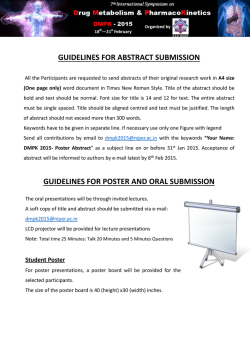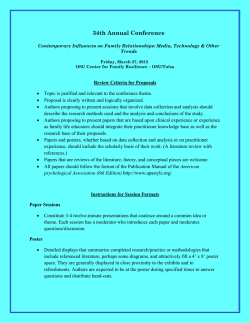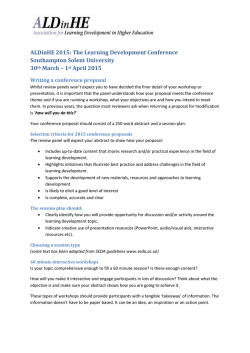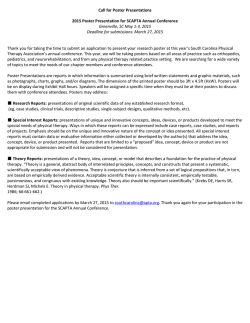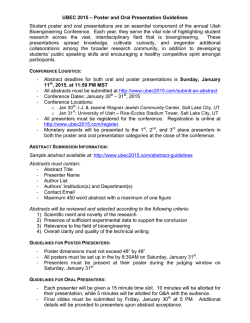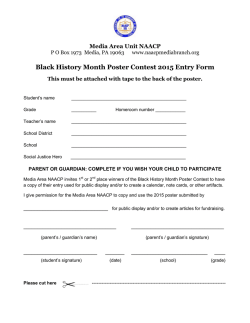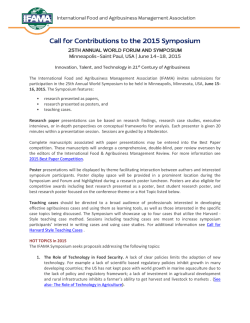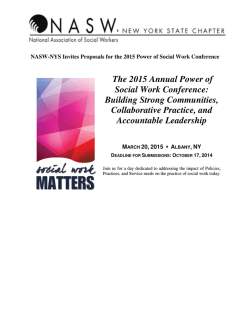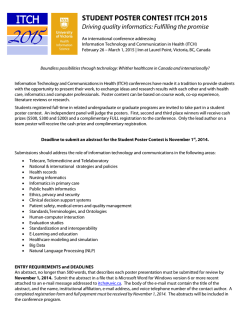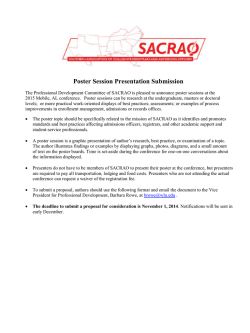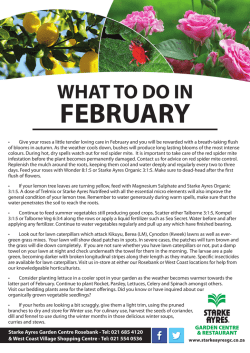
Paper/Poster Submissions - Entomological Society of America
CALL FOR PAPERS AND POSTERS Deadline February 9, 2015 99th PBESA Annual Meeting April 12-15, 2015 Coeur d’Alene Resort, Coeur d’Alene, Idaho The 99th Annual Meeting of the Pacific Branch of the Entomological Society of America will be held at the Coeur d’Alene Resort in Coeur d’Alene, Idaho from April 12-15, 2015. The theme for the meeting is “Celebrating Entomological Discoveries in the Pacific Branch” a celebration of the innovative and creative sciences applied to entomological research. Presentations related to the theme and beyond are welcome! Following the model from the last few years, ALL PAPER AND POSTER SUBMISSIONS will be made online through the CONFEX system we are all familiar with for the national ESA meeting. There will be no form to fill and email to the Program Chair. Presenters for papers and posters must register prior to or at the meeting. Abstracts are only required for student competitions. THE DEADLINE FOR ALL SUBMISSIONS IS FEBRUARY 9, 2015 CONFEX is now OPEN for paper or poster submissions Please note the following specific instructions for student competitions, symposia and 10-minute oral and poster presentations. Please also note the general instructions for oral and poster presentations listed below the specific instructions. GRADUATE STUDENT PAPER/POSTER COMPETITIONS Students can make one presentation in either the oral or the poster presentation competition. Senior authors on the presentations in the competitions must be student members of the Pacific Branch, and be registered for the meeting. First and Second prizes will be awarded at the Awards Luncheon for each of the categories listed below. Oral and poster presentations will be judged on scientific merit of the research, the abstract, organization of the presentation, and clarity in delivery. In the online submission, students will need to select the appropriate categories for their presentation: Oral or Poster and Undergraduate, Masters, or PhD. Students in the competitions must submit an abstract (maximum 250 words) as these will be evaluated by the judges. Students, please copy and paste your abstract from a document or type directly in the box provided. An example of an abstract is included below at the end of the instructions. After entering and saving your abstract, you can continue with your submission. An email will be sent to you as confirmation that you have successfully submitted a paper/poster for the student competition. For those presenting posters, the submitted abstract should appear on your poster and there will be a set time when students will be expected to attend their posters so that they can interact with the judges. To assist students in preparing their oral papers and posters, the judging sheets that will be used for assessing presentations can be downloaded below. Oral Presentations (PDF) Poster Presentations (PDF) SYMPOSIA ORGANIZERS Please obtain title and author information from your invited speakers and submit all of the participants’ information online. The online submission process will offer a list of symposia, so please choose the title of your symposium for each entry. Abstracts are not required to be submitted for symposia presentations. An email will be sent to you as confirmation that you have successfully submitted a paper for your symposium. SYMPOSIA PRESENTERS If you are invited to make a presentation in a symposium by a symposium organizer, please send your title and contact information to the symposium organizer who will submit the information online on your behalf. Abstracts are not required to be submitted for symposia presentations. An email will be sent to you as confirmation that your paper has been submitted for the symposium by the symposium organizer. If you have not been invited by a symposium organizer but wish to participate in a specific symposium, please contact the symposium organizer to determine if your presentation can be added to the symposium. 10-MINUTE PAPER/POSTER PRESENTATIONS Please select the appropriate 10-minute or poster category and submit your title and author(s) information. An abstract is not required for 10-minute paper and poster presentations. An email confirmation will be sent to you after your submission is complete. We request that each meeting attendee submits no more than one oral and one poster presentation (i.e., one of each type of presentation) to allow time for as many presenters as possible. GENERAL INSTRUCTIONS FOR ALL PRESENTATIONS ORAL PRESENTATIONS Confex will NOT upload presentations online for the branch meetings. All presenters will need to upload their PowerPoint presentations in the Presentation Preview Room at the meeting at least 24 hours in advance of their presentation to be pre-loaded on the session computer. If you are unable to be at the meeting the day before your presentation, please bring your presentation on a flash drive to the room of your session half an hour before the session commences. POSTER PRESENTATIONS Posters should be no larger than 46 inches by 46 inches. QUESTIONS/CONTACT If you have any questions or need more information, please contact the PBESA Program Chairs, David Crowder (mail to:[email protected]) or Rodney Cooper (mail to:[email protected]). EXAMPLE FOR FORMAT OF STUDENT COMPETITION ABSTRACTS (REQUIRED ONLY FOR STUDENT PAPER AND POSTER COMPETITIONS) (Times New Roman, 11 font recommended) Development of economic injury levels and sampling plans for spider mites (Tetranychus spp.) in field corn in California Larry D. Godfrey1, Richard R. Lewis1, Kevin E. Keillor1, and Jorge J. Cisneros2 1 University of California, Department of Entomology, One Shields Avenue, Davis, CA 2 Syngenta Crop Protection, Inc, Western Regional Technical Center, 498 N. Mariposa Road, Visalia, CA Differential spider mite population densities were created in commercial corn fields in the San Joaquin Valley using various rates of propargite and abamectin. Effects on silage production and grain production were evaluated. Results from 2000 and 2001 studies showed that the within plant distribution of spider mites followed a ‘bell-shaped’ curve with the highest mite densities on the middle leaves (leaf positions 3 to 7) and the lowest mite densities on the newest leaves and oldest leaves. The 4th leaf in 2000 showed a positive linear relationship between percentage of infested leaves and the cumulative mite-days, indicating that this leaf may be used as a presence/absence sampling method for mite population estimation. Sufficient correlation was not seen in 2001 to support this relationship. Overall, different mite densities were created in plots using miticide treatments. There was a significant trend for lower mite densities in the plots treated with high compared to low miticide concentrations. Hand-infested plots in 2001 resulted in mite densities greater than the untreated control. Despite the different mite populations achieved among plots, no significant differences were found among yields for silage in Yolo County location. A weak linear relationship was found with increased mite populations resulting in decreased grain yields. It is expected that mite populations have to reach higher densities than those observed during 2001 to obtain more significant negative effects on yields. Mite densities in the Kern and Tulare County locations were significantly higher than those in Yolo County. Similar studies are ongoing in 2002.
© Copyright 2025
